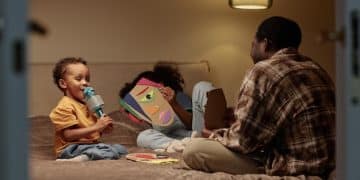Co-Parenting After Divorce: Establishing a Positive Relationship

Co-parenting after divorce requires a strategic approach to ensure the well-being of the children involved. It focuses on open communication, mutual respect, and consistent boundaries.
These elements help foster a stable and supportive environment despite the separation. With effort from both parents, a collaborative system can be built.
Navigating co-parenting can be challenging, but it’s possible to create a positive and supportive dynamic. It begins with a commitment to putting your children’s needs above conflict.
Understanding the Importance of Positive Co-Parenting
Positive co-parenting is essential for children managing the emotional effects of divorce. When parents communicate well, children experience greater stability.
This cooperation minimizes emotional disruption and helps children adjust better. Stability at home leads to improved behavior and mental health.
Failing to co-parent positively can have long-term effects on children’s lives. Emotional development, academic performance, and relationships may all be impacted.
The Impact on Children’s Well-being
Children do better when they witness healthy cooperation between parents. Even after divorce, unity in parenting reduces their stress and anxiety.
This allows them to process changes in their family structure more easily. Stability promotes emotional balance and a sense of safety.
When parents model respect and teamwork, children learn resilience. They feel more confident navigating their own relationships and challenges.
Creating a Stable Environment
Consistency between both homes is a core principle of co-parenting. Aligned routines, rules, and expectations create emotional security for children.
When life feels predictable, children adapt faster and feel grounded. A united approach helps reduce confusion and emotional conflict.
This sense of normalcy is vital during and after separation. It offers children the continuity they need to feel safe and supported.
-
Prioritize open and honest communication with your co-parent.
-
Establish clear boundaries and expectations for both households.
-
Support your child’s relationship with the other parent.
-
Avoid speaking negatively about your co-parent in front of your child.

Step 1: Establishing Clear Communication Channels
Effective communication prevents misunderstandings and tension. It ensures smoother decision-making and fewer emotional flare-ups.
Children benefit when parents speak calmly and respectfully. It keeps the focus on their well-being, not past conflicts.
Consistency in communication strengthens cooperation over time. Structured dialogue encourages problem-solving, not blame.
Choosing the Right Communication Method
Choose what works best: email, co-parenting apps, or shared calendars. These tools reduce friction and maintain clear records.
Agree on methods that suit your schedules and personalities. Avoid emotional messaging during sensitive moments.
Pick systems that help keep things practical and neutral. This builds trust and reduces unnecessary tension.
Setting Boundaries for Communication
Healthy boundaries prevent arguments from escalating. Focus only on child-related matters to avoid distractions.
Respect each other’s time and emotional space. Don’t use communication to rehash past disagreements.
Boundaries keep conversations productive and child-focused. They create emotional safety for everyone involved.
-
Use email or a co-parenting app for logistical matters and scheduling.
-
Reserve phone calls for urgent or time-sensitive issues.
-
Avoid discussing personal matters or past grievances.
-
Keep communication focused on the children’s needs and well-being.
Step 2: Creating a Consistent Parenting Plan
A parenting plan gives structure to two-household families. It minimizes confusion and provides long-term direction.
Consistency in parenting reduces behavioral issues. It ensures children know their routines and expectations.
Having a plan also lowers parent stress. Both adults know what’s expected and how to proceed.
Key Elements of a Parenting Plan
Define custody, schedules, holidays, and responsibilities. Everyone should agree and understand what’s included.
Ensure clarity around education, health, and finances. Avoid vague terms that might create future conflict.
Transparency builds mutual trust and avoids disputes. A solid plan supports smoother day-to-day parenting.
Adapting the Plan as Children Grow
Children’s needs evolve with time. Be open to revisiting the plan and making updates as needed.
Growth means new schools, activities, and preferences. The plan should adjust to reflect those realities.
Cooperation keeps the parenting plan relevant. Flexibility leads to long-term family harmony.
-
Establish a clear custody schedule that outlines when each parent has the children.
-
Define how major decisions regarding education, healthcare, and religion will be made.
-
Outline financial responsibilities for childcare, education, and extracurricular activities.
-
Include provisions for holidays, vacations, and school breaks.
Step 3: Managing Conflict Constructively
Disagreements happen in every co-parenting relationship. What matters is how parents resolve them together.
Healthy conflict resolution protects children from stress. It models emotional intelligence and respectful behavior.
Staying calm prevents small issues from escalating. Focus on solutions, not personal attacks or blame.
Recognizing and Addressing Conflict Triggers
Understand patterns that lead to arguments. Anticipate them and approach those topics with care.
When you see conflict building, take a conscious step back to avoid escalating the situation. Approach the issue later with clarity, composure, and a willingness to resolve it constructively.
Awareness leads to smarter, more thoughtful decisions in co-parenting. By anticipating challenges, you can prevent future friction through better communication and preparation.
Practicing Active Listening and Empathy
Listening to understand, not to respond, builds bridges. Acknowledge your co-parent’s feelings without judgment.
Empathy doesn’t mean agreement. It means showing you care about their viewpoint and experience.
This attitude diffuses anger and builds respect. It also keeps focus on what truly matters: the children.
-
Focus on finding solutions rather than assigning blame.
-
Use “I” statements to express your feelings and needs.
-
Take a break if the discussion becomes too heated.
-
Consider seeking the help of a mediator or therapist to resolve persistent conflicts.
Step 4: Prioritizing Your Child’s Well-Being
Above all, co-parenting is about your child’s needs. Every decision should support their growth and stability.
Even when it’s difficult, put aside personal issues. Unity gives your child emotional peace and balance.
It’s not about being a perfect parent. It’s about consistently showing up with presence, support, and love, every single day, no matter the circumstances.
Creating a Supportive Environment
Show your child they are loved by both parents. Let them feel safe expressing affection for each parent.
Never force your children to choose sides. They deserve the freedom to maintain loving, secure bonds with both parents without guilt or pressure.
This kind of support helps children feel emotionally secure and balanced. It also eases any feelings of guilt, pressure, or confusion they may experience during the transition.
Attending to Emotional Needs
Children process divorce differently depending on age and personality. Stay attuned to changes in mood or behavior.
Create space for open conversations about feelings. Don’t dismiss their confusion or sadness.
Your presence and reassurance build resilience. It teaches them to trust and express their emotions.
-
Encourage your child to express their feelings openly and honestly.
-
Reassure your child that the divorce is not their fault.
-
Avoid placing your child in the middle of conflicts between you and your co-parent.
-
Seek professional help for your child if they are struggling to cope with the divorce.

Seeking Additional Support and Resources
Even with a plan, co-parenting can be overwhelming. Professional support makes the journey easier.
Therapists and coaches offer tools to manage conflict. Support groups provide community and guidance.
Reaching out isn’t a sign of failure, it’s a mark of wise, responsible parenting. Support is available, and those who seek it are taking a powerful step toward growth.
Therapy and Counseling
Therapy offers a safe space for honest discussion. It helps both adults and children process emotions.
A counselor can mediate co-parenting conflicts effectively. They teach communication and conflict-resolution skills.
Support improves emotional health and family harmony. It builds long-term stability and trust.
Support Groups and Online Resources
Talking to others going through the same thing helps. Peer advice and shared experiences reduce isolation.
Online articles, apps, and forums offer strategies. Many are free, accessible, and easy to use.
These resources empower parents to improve. Learning from others builds skill and confidence.
-
Consult with a family therapist specializing in divorce and co-parenting.
-
Join a support group for divorced parents.
-
Explore online resources such as articles, blogs, and forums.
-
Consider mediation to resolve particularly challenging disputes.
| Key Point | Brief Description |
|---|---|
| 🗣️ Communication | Establish clear and respectful communication channels. |
| 📅 Parenting Plan | Create a consistent plan for routines and decision-making. |
| 🤝 Conflict Management | Manage conflicts constructively. |
| ❤️ Child’s Well-being | Always prioritize the child’s emotional and physical needs. |
Frequently Asked Questions (FAQ)
▼
Use a neutral communication channel like email or a co-parenting app. Focus on facts, avoid emotional language, and stick to topics concerning the children. Active listening can foster a more respectful dialogue.
▼
The parenting plan should include a detailed schedule, decision-making procedures, financial arrangements, and conflict resolution strategies. Make sure it’s flexible and revisable, addressing the children’s evolving needs as they grow.
▼
Focus on the child’s needs and negotiate towards a middle ground. If disagreements persist, consider mediation to help find a mutually acceptable solution. Consistency is more crucial than uniformity across households.
▼
Document all interactions and adhere strictly to the court’s orders. Seek legal advice and consider involving a mediator to facilitate communication. Focus on what you can control and maintain a consistent, loving environment for the children.
▼
Provide a stable and supportive environment. Listen to their feelings without judgment and reassure them that they are loved by both parents. Consider therapy for your child if they exhibit signs of stress or difficulty coping.
Establishing a positive co-parenting relationship after divorce is a journey that requires commitment, patience, and a focus on your children’s well-being.
By establishing clear communication channels, creating a consistent parenting plan, managing conflict constructively, and prioritizing your child’s needs, you can create a supportive and stable environment for your children to thrive.





